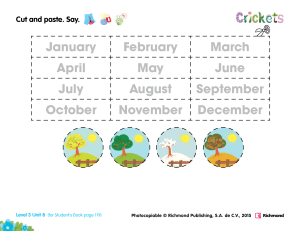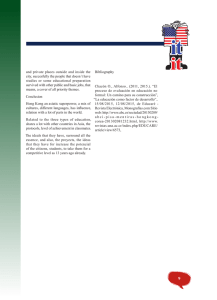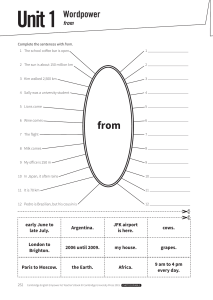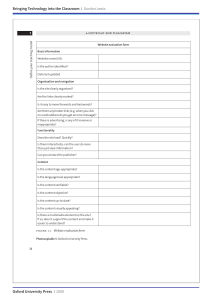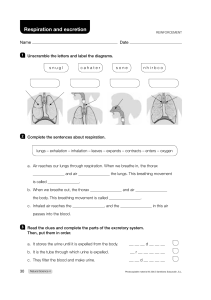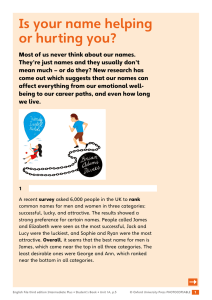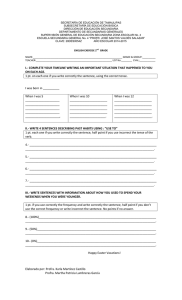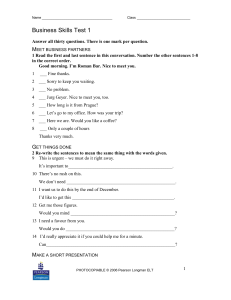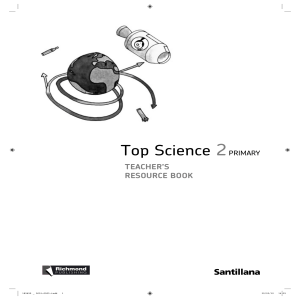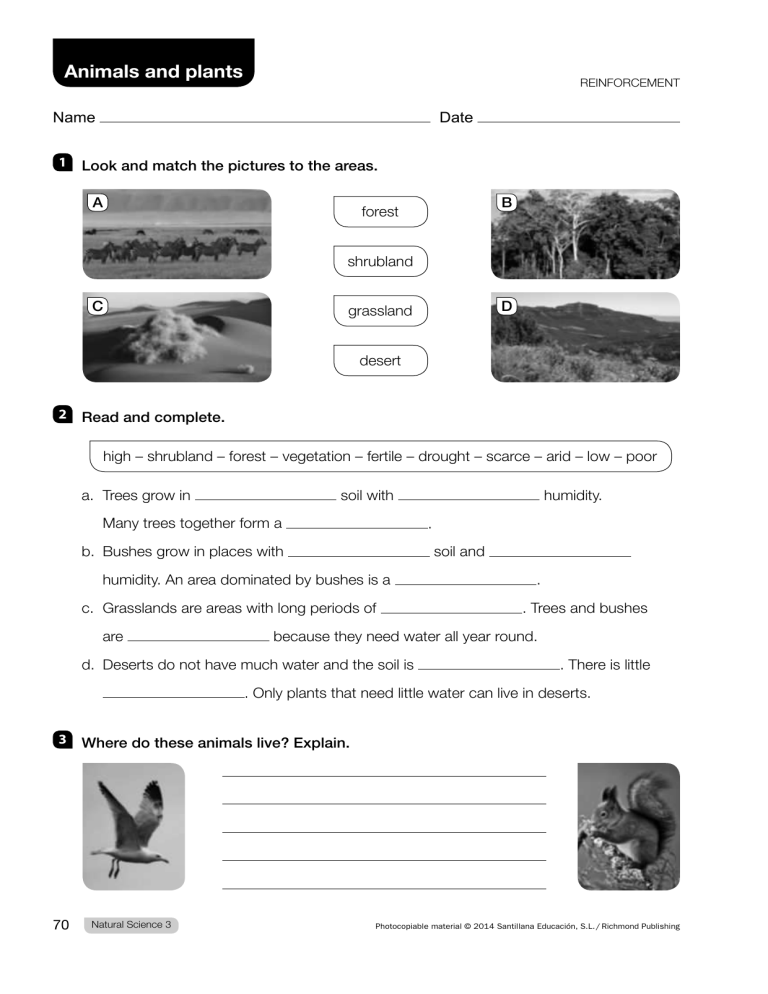
Animals and plants REINFORCEMENT Name 1 Date Look and match the pictures to the areas. A B forest shrubland C D grassland desert 2 Read and complete. high – shrubland – forest – vegetation – fertile – drought – scarce – arid – low – poor a. Trees grow in soil with Many trees together form a . b. Bushes grow in places with soil and humidity. An area dominated by bushes is a c. Grasslands are areas with long periods of are humidity. . . Trees and bushes because they need water all year round. d. Deserts do not have much water and the soil is . There is little . Only plants that need little water can live in deserts. 3 70 Where do these animals live? Explain. Natural Science 3 Photocopiable material © 2014 Santillana Educación, S.L. / Richmond Publishing REINFORCEMENT 4 5 Find and circle eight animals. Then, write. s e a b i r d f p x s n a k e l i s z f w t q x i s n s t a r f i s h a s q u i r r e l i o o c t o p u s l Classify these marine animals. whales – seals – sharks – sardines – turtles – tuna They breathe through lungs 6 They breathe through gills Write T (true) or F (false). a. Sponges are marine invertebrates. b. Elephants are terrestrial mammals. c. Seabirds live in small tunnels underground. d. All fish live in fresh water. e. Snakes haven’t got legs, so they slither. f. Corals move about the seabed. Photocopiable material © 2014 Santillana Educación, S.L. / Richmond Publishing Natural Science 3 71 Animals and plants EXTENSION Name Date A frozen land Tundras are one of the coldest and harshest areas on Earth. They are found in the Arctic, where the weather is extremely cold, dry and windy. Trees cannot grow in tundras, but there are many low plants. The Arctic tundra has average temperatures of –12 ºC to –6 ºC. This means that the top layer of soil, called the permafrost, is almost always frozen. In winter, the permafrost is covered with a thick layer of snow, and no plants are visible. In summer, there are 24 hours a day of sunlight, and the surface of the permafrost melts. Wildflowers appear everywhere. Many animals live in the Arctic tundra, including Arctic foxes, polar bears, caribous and snow geese. Unfortunately, as a result of global warming, temperatures are rising. This is causing the permafrost to melt. The Arctic tundra is in danger. 1 Read the text and circle the correct word. a. Tundras are found in the Arctic / Antarctic. b. In the summer, there are 12 / 24 hours a day of sunlight. c. The top layer of the soil is the tundra / permafrost. d. Winter in the Arctic tundra is extremely warm / cold. e. Global warming / Acid rain is harming the Arctic tundra. 2 Search the Internet for three animal species from the Arctic tundra. Write what they eat. animals 72 Natural Science 3 food Photocopiable material © 2014 Santillana Educación, S.L. / Richmond Publishing Animals and plants EXTENSION Name Date Fast and slow animals Animals move at different speeds. Walking at a normal pace, people usually walk five or six kilometres per hour. Some very slow animals take a whole year to travel the same distance as a fast animal can travel in one hour! animals on land 1 in the air in water slow animals Sloths move at 12 metres per hour. Small flies move at 35 kilometres per hour. Perches swim at 2.1 kilometres per hour. fast animals Cheetahs can run at 100 kilometres per hour. Falcons can fly at 300 kilometres per hour. Sailfish can swim at 110 kilometres per hour. Read the text and the table. Then, answer the questions. a. Which animal is the slowest on land? b. Which animal is the fastest on land? c. Does the slowest animal move on land, in the air or in water? d. Does the fastest animal move on land, in the air or in water? 2 Find your favourite animal on the Internet. Draw it. Then, find out how fast it moves and complete the sentences. My favourite animal is the . It moves at . Photocopiable material © 2014 Santillana Educación, S.L. / Richmond Publishing Natural Science 3 73 Animals and plants ASSESSMENT Name 1 Write the names of these areas. A 2 Date B C D Read and write T (true) or F (false). Then, correct the false sentences. a. Vegetation depends on soil, climate, relief and humidity. b. Pines, oaks and beeches are types of bushes. c. The African Savannah is a grassland area. d. Deserts are areas with fertile soil and high humidity. e. Grass in grasslands dies in drought periods. 3 What is vegetation? Explain. 4 Read and complete the words. 74 a. All the plants in an area, region or country. v g t b. A long period of little or no rainfall. d o t c. A grassland area in Africa. s v d. An area dominated by bushes. s Natural Science 3 h u d Photocopiable material © 2014 Santillana Educación, S.L. / Richmond Publishing ASSESSMENT 5 Read the text and complete. oxygen – lungs – surface – marine – rivers Some aquatic animals live in the sea. They are animals. Others live in fresh water, in lakes or . Aquatic animals spend most of their lives in water. Many of them breathe in from the water through gills. Others come to the of the water to breathe in air, through 6 . Circle the correct animal. bat / bird a. A mammal that can fly. b. A mollusc that lives fixed to the rocks on the seabed. skater / butterfly c. An insect that glides on the surface of the water. snake / salamander d. A reptile that slithers. eagle / duck e. A water bird. 7 sea urchin / mussel Read, then write the correct word. a. Squirrels live most of the time in and swing from branch to branch. trees – bushes – tunnels b. Snakes haven’t got legs, so they . fly – slither – jump c. Many small animals live in tunnels . in the sea – in small houses – underground Photocopiable material © 2014 Santillana Educación, S.L. / Richmond Publishing Natural Science 3 75 Animals and plants TEST Name 1 Date Vegetation is… a. all the plants that live in an area, region or country. b. all the plants and animals that live in an area. c. the flowers that grow on trees. 2 Many trees growing together make up a… a. grass area. 3 c. desert. We obtain honey and wax from… a. bees. 4 b. forest. b. spiders. c. sheep. Shrublands are areas… a. with long periods of drought where forests cannot grow. b. dominated by bushes. c. dominated by cactuses. 5 African savannahs are… a. deserts. 6 b. forests. c. grasslands. A desert is… a. an area where there is a lot of sand. b. an area with arid soil and little water. c. a kind of vegetation. 7 Corals live in… a. the sea. 8 b. fresh water. c. either the sea or fresh water. Marine mammals, like dolphins or whales, … a. must come up to the surface to breathe. b. don’t need to breathe air from the surface. c. breathe through gills. 9 Terrestrial animals… a. do not need water. b. live on land. c. have wings to walk about. b. seabird. c. slithering reptile. 10 A bat is a… a. flying mammal. 76 Natural Science 3 Photocopiable material © 2014 Santillana Educación, S.L. / Richmond Publishing Animals and plants Name 1 INVESTIGATE Date Which animals and plants share the same area? Instructions 1. Work in groups. 2. Choose one of these areas: shrubland, desert, grassland or forest. 3. Search the Internet for plants and animals that live in your habitat. Find out what they eat and how they reproduce. Print out or draw pictures. 4. Make a poster with your pictures. Write the names of the animals, what they eat (carnivore, herbivore or omnivore) and how they reproduce (oviparous or viviparous). 5. Show your poster to your classmates and tell them about your favourite animal or plant. Photocopiable material © 2014 Santillana Educación, S.L. / Richmond Publishing Natural Science 3 77
